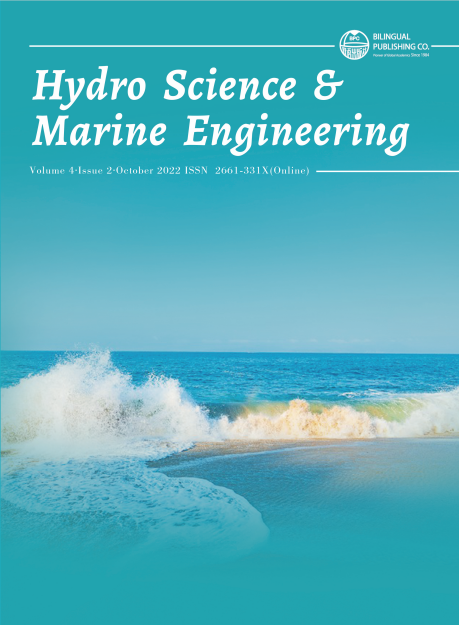Effect of Mutual Interference of Bridge Piers on Scouring in Meandering Channel
DOI:
https://doi.org/10.30564/hsme.v4i2.4692Abstract
Local scour is the reduction of original bed level around any hydraulic structure. Bridge failure due to scouring has made researchers study the cause of scouring and predict the scour depth and pattern around bridge piers and foundations. Several investigators have extensively studied local scour around isolated bridge pier, but modern designs of the bridges comprise of wide span and thus group of piers rather than a single pier. The flow and scour pattern around group of piers are different from the case of a single pier due to the interaction effect. The objective of present study is to investigate the effect of mutual interference of bridge piers on local scour experimentally around two piers in non-cohesive bed. Experiments were carried out on model bridge piers of circular cross section in a meandering channel. It was observed that when front and rear piers were placed at an angular displacement of θ = 40° and 80° respectively, maximum depth of scour is maximum. Here θ is the angle the line drawn at the inlet of bend to the line joining the centre of curvature and any point on the outer portion of the bend.
Keywords:
Local scour; Bridge piers; Scour depth; Meandering channel; Angular displacementReferences
[1] Melville, B.W., Sutherland, A.J., 1988. Design method for local scour at bridge piers. Journal of Hydraulic Engineering. 114, 1210-1226.
[2] Debnath, K., Chaudhuri, S., 2010. Bridge Pier Scour in Clay-Sand Mixed Sediments at Near-Threshold Velocity for Sand. Journal of Hydraulic Engineering. 136(9), 597-906.
[3] Garde, R.J., Kothiari, U.C., 1997. Scour around bridge piers. 6(4), 569-580.
[4] Garde, R.J., Raju, K.G.R., 2014. Mechanics of Sediment Transportation and Alluvial Stream Problems. New Age International (P) Ltd,. Publishers.
[5] Ting, F.C.K., Briaud, J.L., 2001. Flume Tests for Scour in Clay at Circular Piers. Journal of Hydraulic Engineering. 127(11), 969-978.
[6] Elsebaie, I.H., 2013. An Experimental Study of Local Scour Around Circular Bridge Pier in Sand Soil. International Journal of Civil & Environmental Engineering. 13(1), 23-28.
[7] Emami, Y., Salamatian, S.A., Ghodsian, M., 2008. Scour at Cylindrical Bridge Pier in a 180 Degree Channel Bend, Fourth International Conference on Scour and Erosion. pp. 256-262.
[8] Masjedi, A., Bejestan, M.S., Kazemi, H., 2010. Effects of Bridge Pier Position in a 180 Degree Flume Bend on Scour Hole Depth. Journal of Applied sciences. 10(8), 670-675.
[9] Elsaeed, G., Elsersawy, H., Ibraheem, M., et al., 2015. Determination of Scour holes around Bridge piers in meandering Channels. Journal of International Association of Advanced Technology and Science. 16(9), 1-12.
[10] Ajeel, S., Gholami, A., Bonakdari, H., et al., 2016. Comparison of flow pattern in a 60° sharp bend by using Fluent software and artificial neural network, support Vector Machine Methods, Mesopotamia Environmental Journal. 2(2), 27-39.
[11] Matooq, J.S., Mahmood, E.S., 2017. Local Scour around Single Central Oblong Bridge Piers Located within 180° Bend. Journal of Hydraulic Engineering.
[12] Matooq, J.S., Mahmood, E.S., 2018. Local Scour around single Central Circular Bridge Pier located within 180o Bend. Journal of Engineering and Applied Sciences. 13(5), 1639-1648.
Downloads
Issue
Article Type
License
Copyright © 2022 Authors

This is an open access article under the Creative Commons Attribution-NonCommercial 4.0 International (CC BY-NC 4.0) License.
Copyright and Licensing
The authors shall retain the copyright of their work but allow the Publisher to publish, copy, distribute, and convey the work.
Hydro Science & Marine Engineering publishes accepted manuscripts under Creative Commons Attribution-NonCommercial 4.0 International License (CC BY-NC 4.0). Authors who submit their papers for publication by Hydro Science & Marine Engineering agree to have the CC BY-NC 4.0 license applied to their work, and that anyone is allowed to reuse the article or part of it free of charge for non-commercial use. As long as you follow the license terms and original source is properly cited, anyone may copy, redistribute the material in any medium or format, remix, transform, and build upon the material.
License Policy for Reuse of Third-Party Materials
If a manuscript submitted to the journal contains the materials which are held in copyright by a third-party, authors are responsible for obtaining permissions from the copyright holder to reuse or republish any previously published figures, illustrations, charts, tables, photographs, and text excerpts, etc. When submitting a manuscript, official written proof of permission must be provided and clearly stated in the cover letter.
The editorial office of the journal has the right to reject/retract articles that reuse third-party materials without permission.
Journal Policies on Data Sharing
We encourage authors to share articles published in our journal to other data platforms, but only if it is noted that it has been published in this journal.




 Mohammad Athar
Mohammad Athar

